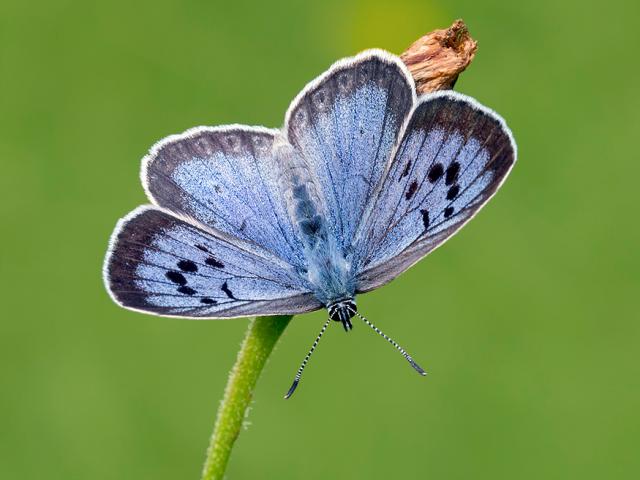
This funded project has helped to increase the area of suitable habitat for Large Blue in the Polden Hills Landscape.
The Large Blue Maculinea arion is the UKs rarest butterfly and globally endangered.
The Polden Hills supports nearly 80% of the Large Blue's population in Britain. This landscape scale project will create a network of sites that contain sufficient suitable habitat to encourage the species to expand its range beyond the current occupied sites.
The Large Blue breeds in well drained unimproved grassland, predominately in Limestone or coastal grassland. The adult lays its eggs on Wild Thyme Thymus polytrichus flower heads which are the larval foodplant. Breeding success is best in grasslands with a short turf where the host ant Myrmica sabuleti is abundant.
The Limestone grassland sites in the Polden Hills are its current stronghold in the UK. Historically this species became extinct in the UK through a combination of factors that led to the loss of unimproved grassland through habitat destruction and abandonment and changes in management.
Since the Large Blue became extinct in the UK in 1979, the combination of research and conservation has resulted in the most successful insect conservation programme in the world. Since its re-introduction to sites in the UK in 1984 the number of successful colonies in the South west has increased to a total of 30 in 2008.
The project started in June 2011 and finished in June 2014.
Project Aims
Expanding the Large Blue Butterfly Landscape in the Polden Hills aims to extend the current area of suitable habitat for the Large Blue across 14 Limestone Grassland sites. The project focuses on expanding the area of habitat through restoring a network of previously occupied Limestone grassland sites and creating suitable habitat for this butterfly and other associated species. This also includes maintaining and increasing the area of suitable habitat in currently occupied sites.
We are specifically aiming to:
- To restore suitable habitat on currently unoccupied sites to the west of the main Poldens Ridge where the butterfly was known to support large populations in the early 1800s.
- To restore further habitat on occupied sites where the populations are not believed to be self-sustaining.
- To restore further habitat on sites with the greatest potential to act as source populations for colonisation of unoccupied sites
Methods
- Restoration and maintenance of Limestone grassland through targeted scrub management.
- Habitat assessments to guide the grassland restoration and management.
- Monitoring the habitat condition and Large Blue populations in response to restoration and management of sites.
- Thyme propagation by local nurseries for planting on sites to be restored and improved.
- Support and train local groups and volunteers to assist with conservation management and monitoring.
Results
- 11147 Wild Thyme plants were planted on seven project sites to increase the foodplant resource for the Large Blue.
- Over 10ha of scrub was managed throughout the project sites to restore and enhance habitat.
- 175 days of follow up ruderal control was undertaken to control regrowth following scrub management.
- Detailed surveys of the habitat, ants, foodplants and Large Blue populations were undertaken to help direct habitat management (scrub management, thyme planting and grazing).
- Volunteers were crucial in helping to manage and monitor sites and contributed 357 to scrub management and thyme planting and further days in helping to monitor project sites.
- There has been one new colonisation and three re-colonisations during the duration of the project, however the extreme weather conditions locally have not been ideal for the ants, foodplant and adult butterfly which will have had an impact on butterfly movement.
Delivery
The project is managed by Butterfly Conservation’s Species Team based at our Head Office, overseen by Dr Caroline Bulman. Conservation Officer, Rachel Jones manages the delivery of the site restoration work, which includes scrub management, ruderal weed control, food-plant propagation and planting. Local contractors and volunteers carry out this vital work.
Highly experienced Large Blue contractor David Simcox is leading the research that underpins the project, undertaking surveys of food-plants, butterflies and ants and to advise on targeted management including scrub clearance and grazing regimes. The management and grazing on the project sites is carefully targeted using the results of habitat assessments, Large Blue monitoring and ant surveys. Each site manager and or owner receives detailed advice on where to target the scrub management with a tailored grazing regime according to the live- stock used by their grazier.
Partners
This project was developed by Butterfly Conservation and works closely with the National Trust, Somerset Wildlife Trust, South Somerset District Council, the J&F Clark Trust and private landowners.
Project Funders
SITA Trust and BBC Wildlife Fund and match funding from the Butterfly Conservation Large Blue Appeal. The project partners generously contribute their staff’s time
Project Acknowledgements
The Large Blue Project is underpinned by science, carried out by Oxford University and CEH and implemented by a collaborative partnership between Butterfly Conservation, CEH, Gloucestershire Wildlife Trust, J&F Clark Trust, National Trust, Natural England, Network Rail, Oxford University, Somerset Wildlife Trust, South Somerset District Council and private landowners.
Where to Visit
The best site to see the Large Blue in flight is at the National Trust site, Collard Hill (http://www.nationaltrust.org.uk/article-1356396112443/). Please use the link to find out more and how to get there. Other project sites are either closed to the public during the flight season or on private land.
Contact
Rachel Jones, Conservation Officer, Butterfly Conservation, email; [email protected] or direct line: 01929 406018

